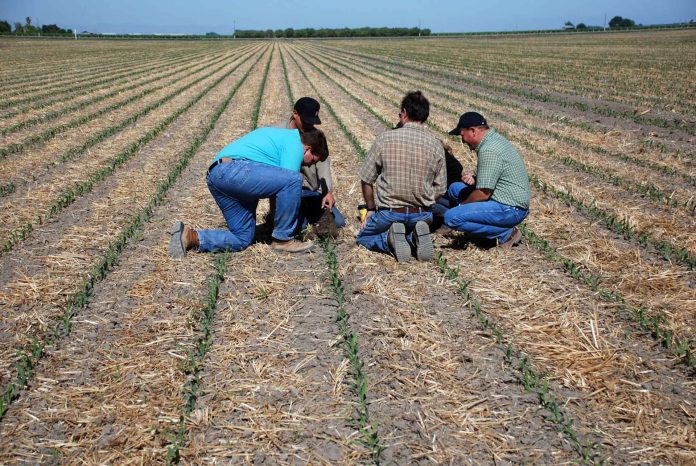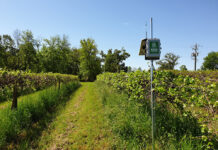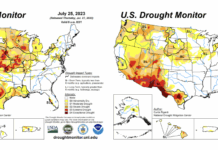
Soils are essential for life on earth. In addition to the fundamental role of soil in agriculture, soils support building and recreation, filter and store water, recycle nutrients, protect our communities from flooding, sequester carbon, and due to the wide microbial diversity of soils, have even been a source of antibiotic and prescription drug discovery. Soils are alive! In fact, up to one billion bacterial and several yards of fungal hyphae can live in a single gram of soil. These microbes, invisible the naked eye, are at the core of many of our soil building management practices.
Despite being one of our most important natural resources, we may not often think about soil as something that needs to be built or protected. Unfortunately, soils globally and in the United States are being destroyed at a rapid rate. Soil is a non-renewable resource and once a soil has been degraded to the point where it cannot be used to produce crops, it is very challenging, if not impossible, to restore. As President Franklin Delano Roosevelt once said, “the nation that destroys its soil, destroys itself.” The United States Department of Agriculture (USDA)/National Resources Conservation Service (NRCS) estimates that the annual cost of soil erosion in the United States alone is $44 billion. While we cannot re-create soil once it is destroyed, we can employ on farm management practices to reduce the risk of soil destruction and to increase soil function.
The main principles of soil health are to maintain soil cover, minimize soil disturbance, keep a living root in the soil, and incorporate plant diversity. These principles are intended to keep soils alive by encouraging flourishing soil microbial communities and physically protecting soils from either loss or structural damage. Soil microbes are a critical part of soil health because of the role they play in nutrient cycling and building soil aggregates. Soil aggregates are clumps of soil particles that are bound together, leaving more available space for air and water. Aggregates are held together by organic matter (like roots), organic compounds (produced by soil microbes), and fungal hyphae. Microbes get nutrients and energy from the carbon found in soil organic matter. This is the reason that many soil health practices involve increasing soil organic matter—it provides food for soil microbes which increases their activity and population. Consider this: soil microbes are necessary for the conversion of nitrogen from one form to another (like ammonium to nitrate) and they need carbon to thrive.
Maintaining Soil Coverage
Bare soil is more susceptible to wind and water erosion, as well as to surface compaction. Our top soil is the most nutrient-rich part of the profile so when we lose soil to erosion we are losing our most valuable soil to the environment. Although loss of soil to erosion may seem minor from year to year, when we consider that it takes 500 years to form an inch of topsoil, if we are losing just 1/100 of an inch of topsoil to erosion a year, we are still losing soil five times faster than it is being formed. Surface compaction develops when rain and irrigation water hits tilled soil, which forms a soil crust. Maintaining soil coverage throughout the year physically protects soil and provides a range of other benefits like reducing soil evaporation rates, moderating soil temperature, and suppressing weed growth. In annual systems we can keep our soil covered by planting a cover crop during our fallow season. Keeping crop residue on the field is also effective (Figure 1).
Minimize Soil Disturbance
As described above, soil microbial activity is critical for soil aggregate formation and stability. Tillage practices disrupt this activity and break the fungal hyphae and roots that are holding aggregates together. Although it may seem that tillage increases soil pore space, this benefit is short lived. This is because individual particles break off aggregates in recently tilled soils and can fill in pore spaces. A healthy soil has about 50 percent open pore space (half filled with air and half filled with water). Soil pores are where roots grow and microbes thrive. There are other management practices to minimize soil disturbance. These include not working or driving over soil when it is wet, distributing tractor weight over a larger surface area to reduce pressure on specific points in the field, and reducing the number of trips over a field when possible. Even if converting to no-till isn’t realistic for your farm, reducing the number of passes with the disc over a field and using vertical instead of horizontal tillage are ways to minimize soil disturbance. California farmers in a number of regions are now experimenting and sharing their experiences with reduced disturbance production systems like direct seeding into crop residue from the previous crop with little soil disturbance (Figure 2). Ongoing summaries of this work may be found at http://casi.ucanr.edu/

Keep a Living Root in the Soil
Plant roots release small carbon-based compounds called root exudates, which are a mix of sugars, amino acids, enzymes, organic acids and other compounds. These exudates can help breakdown mineral nutrients, leading to increases soil fertility. They also serve as a source of food for soil microbes. Maintaining a living root in the soil helps keep our soil alive throughout the year. Many beneficial microbes cannot survive in a low-carbon environment and keeping a living root is yet another tool for maintaining consistent soil carbon levels. In general, keeping our soils alive throughout the year will increase soil function. Cover crops that are inserted into rotations as possible are a means for achieving this soil health principle. As part of a California Department of Food and Agriculture Healthy Soils Program grant, my colleagues and I are experimenting with planting cover crops during the fallow season. In San Joaquin County, UC Cooperative Extension farm advisors Michelle Leinfelder-Miles and Brenna Aegerter, are researching the effects of a warm-season legume cover crop between winter small grains rotations. In Sutter County, Amber Vinchesi-Vahl and I are researching the effects of a winter cover crop, at different seeding rates, between summer cash crops (Figure 3). Our projects are entering the second of a third-year project, and we look forward to reporting the results on soil health and crop yields in the future.
Incorporate Plant Diversity
In annual systems this is called crop rotation. Crop rotation is beneficial for many reasons. It breaks disease cycles by starving out pathogens that can only thrive on specific plants (or plants in a specific family). In addition, crops with different rooting depths will mine nutrients, release carbon compounds, and improve soil structure at different depths of the soil profile. Finally, plants form symbiotic relationships with various microbes, but these relationships are often species specific. When we incorporate plant diversity into our systems we also build up the diversity in our soil microbial populations. In perennial systems, plant diversity can be achieved by planting a cover crop in between crop rows.

Although soil biology is an important component of soil health, it is not the only consideration. It’s also important to remember the rules of soil fertility including the 4Rs and the Law of the Minimum. As a reminder, the 4Rs refer to the Right Rate, the Right Source, the Right Timing, and the Right Mode of Application. These principles allow us to optimize our fertilizer application by ensuring the greatest nutrient use efficiency. This reduces the risk of loss to the environment and can increase the bottom line. Liebig’s Law of the Minimum refers to the idea that the limiting factor has to be addressed first. In other words, the soil issue (pH, nutrient status) that is most restricting yield is the one that has the greatest potential to improve yield. If the pH is yield limiting, no amount of fertilizer application will fix this problem.
Maintaining soil health is the long game and changes may not be apparent for several years. However, the more the management practices outlined above are incorporated into our farming systems, the greater the likelihood of long-term viability and protection of arable land. In addition to the benefits already discussed, soil water dynamics can be improved by increased water infiltration and water storage. Every farming system is unique and some of the practices may be cost-prohibitive or not viable for some other reason. The goal should be to incorporate as many of the practices that will work in our farm systems as often as we can. Every opportunity to build and protect our soil will ensure the long-term economic viability of our farms, as well as food security for our growing global population.


















